Austen Family Churches
 The Anglican Church and the clergy were an important part of Jane Austen’s life.
The Anglican Church and the clergy were an important part of Jane Austen’s life.
Her father, her brothers James and Henry, and four cousins were clergymen. She lived with her family in the parish rectory at Steventon until she was 25 years old.
The English churches listed below have ties to Jane Austen or her family. For Janeites taking an armchair tour of the churches or planning a trip to England, we offer brief summaries of each church's Austen ties as well as links to a location map and the church website. For JASNA members who would like to know how donations to Jane Austen's family churches have been used, we also note which have received a grant from JASNA to help fund projects.
Read about the Austen family churches and the church and clergy in her fiction.
St. Nicholas Church, Steventon, Hampshire | Show Details ↓
Location Map
Benefice Website Church Website
Steventon Village Website
Contact: wrights@flyingpiano.plus.com
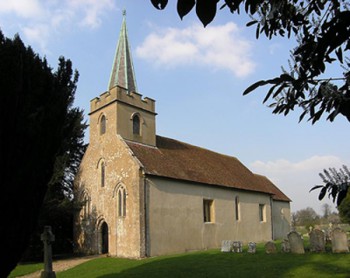
Photo © Allan Soedring
The church of St. Nicholas, Steventon, played a significant role in Jane Austen's life. She was baptized in the church on April 5, 1776, and attended worship there for 25 years. Her father, the Rev. George Austen, was rector of the church from 1761 until his death in 1805. Her brother James became curate of the church in 1801 when George Austen moved to Bath and succeeded his father as rector from 1805-1819. Her brother Henry was rector from 1820-1823, and her nephew William Knight followed as rector from 1823 to 1873, completing over 100 continuous years of Austen/Knight rectors at St. Nicholas.
In Austen's time the church did not have the tall, pointed steeple, but the yew tree in front is said to be over 900 years old and would have been very familiar to her.
Past JASNA Grants and Their Uses
- 1995: Restoration of the church bells (commemorated by a bronze plaque)
- 1999: Crystal cruets with stoppers and a Shell and Gadroon silver-plated tray used for communion (from JASNA's Ohio North Coast Region in memory of Janet "Shammy" Waidelich)
- 2000: Wooden font cover of English and American Oak (partially funded by JASNA's Dayton, Ohio and Wisconsin Regions)
- 2003: Fire screen for fireplace in north wall of the nave (gift of JASNA's North Coast Ohio Region)
- 2007: Candlesticks, donated in memory of Joseph Bown, churchwarden for 25 years
- 2010: Restoration of interior Victorian wall paintings; column repair
- 2015: New heating system under the pews
- 2016: Redecorating the church chancel and nave

Altar with candlesticks (photo © Lynn Sherick)
Holy Trinity and St. Andrew's Church, Ashe, Hampshire | Show Details ↓
Location Map (Click on the "Find Us" tab to display a map.)
Benefice Website Church Website
Contact: sueheadley@uwclub.net
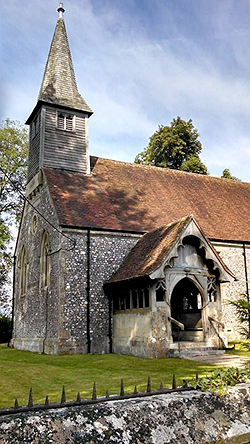
Photo © Amanda Jacobs
Ashe is only a mile or so from Steventon, and Jane Austen was familiar with St. Andrew's during her early life. (The name of the church later became Holy Trinity and St. Andrew.) The Rector Rev. George Lefroy and his wife, Anne, were friends of the Austens. Mrs. Lefroy, sometimes called "Madam Lefroy," was a friend and mentor to Jane Austen. She was killed in a riding accident on Austen's 29th birthday and is buried in the churchyard at Ashe.
There has been a church in Ashe since before Domesday (1086), but the present building dates from 1878. Currently, services are held twice a month.
All Saints Church, Deane, Hampshire | Show Details ↓
Location Map (Click on the "Find Us" tab to display map.)
Benefice Website Church Website
Contact: colesdeirdre@gmail.com

Photo © Amanda Jacobs
The medieval church Jane Austen would have known was replaced in 1818 with a church in the gothic style. The parish is adjacent to Austen's home parish of Steventon. Her father was Rector of Deane from 1773–1805. Jane Austen's brother James was curate from 1792-1805.
Currently, services are held only twice a month.
Past JASNA Grants and Their Uses
- 2009: Roof repairs
St. Nicholas Church, Chawton, Hampshire | Show Details ↓
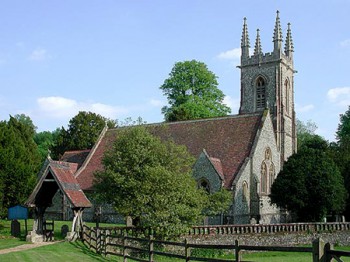
Photo © Allan Soedring
St. Nicholas Church is situated within the grounds of the great house owned during Jane Austen's lifetime by her brother Edward (now Chawton House Library). Located near the cottage in which the Austen women lived, this was their parish church.
The current church dates from the early 1870s; a fire destroyed most of the building in 1871, and very little of the medieval church that Jane Austen knew remains except the chancel and the Knight family memorials saved from the fire.
Many of the memorials in the church are for the Edward Austen Knight family and their descendants. Austen’s mother and sister are buried next to each other in the ancient churchyard,
Past JASNA Grants and Their Uses
- 2001: Repairs
- 2006: Repair and restoration of bells for bicentennial of Jane Austen’s arrival in Chawton; plaster and floor repair
- 2008: Tables; hymnals
- 2013: Organ replacement
- 2014: Boundary wall repair
- 2015: Repair of wall near the graves of Jane Austen's mother and sister
- 2017: Repair of only wall remaining from original church; contribution to commemorative statue of Jane Austen, which will be placed in the churchyard
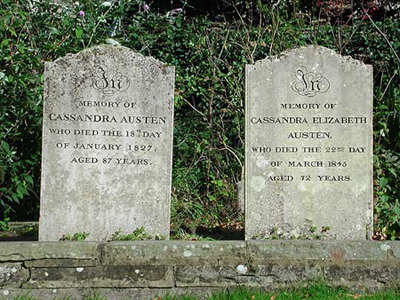
Gravestones of Jane Austen's mother and sister
(photo © Allan Soedring)
Winchester Cathedral, Winchester, Hampshire | Show Details ↓
Location Map
Church Website
Contact: cathedral.office@winchester-cathedral.org.uk

Photo © Carol Moss
In May 1817 Jane Austen moved with her sister, Cassandra, from Chawton to Winchester to receive medical treatment. Her health continued to fail, and she died in Winchester on July 18, 1817. She is buried in Winchester Cathedral in the north aisle of the nave. A memorial window overlooks the grave site, and the cathedral has created an educational display about Austen. Visitors come from around the world to pay their respects at her grave.
Past JASNA Grants and Their Uses
- 2010: "The Jane Austen Story" on display in the cathedral
- 2012: Production of the Jane Austen portion of the cathedral’s “Chronicle of Light” event
- 2015: Development of sculpture to celebrate Jane Austen's life
- 2017: Binding the cathedral's "Book of Memories," a compilation of the personal thoughts recorded by visitors to Jane Austen's grave in commemoration of the 200th anniversary of her death
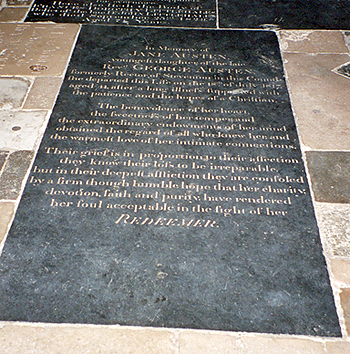
Jane Austen's Grave (photo © Lynn Sherick)
St. Lawrence the Martyr Church, Godmersham, Kent | Show Details ↓
Location Map (Click on the "Find Us" tab to display map.)
Church Website
Contact: lloydbiltinghq@gmail.com
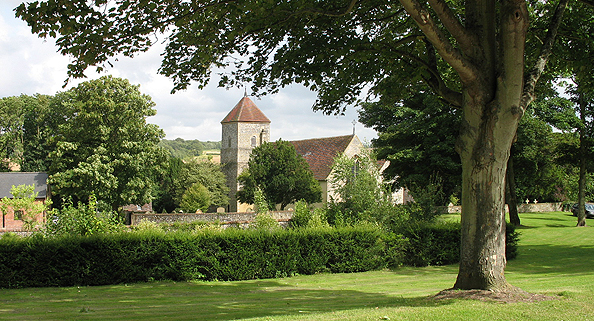
View of church, walking from the house (photo © Lynn Sherick)
St. Lawrence the Martyr is located in Godmersham, Kent, on the grounds of Godmersham Park, the estate inherited by Jane Austen's brother Edward from his adoptive parents, Thomas and Catherine Knight. Jane Austen and her sister, Cassandra, attended the church often during their extended visits with Edward and his family.
When Jane Austen attended services in the church, she sat in the Knight Pew in the south transept. The pew was on the right and was entered by a staircase of six steps. The entrance to the church in Jane Austen’s time was in the center of the West end, which was blocked up in 1865.
Susanna Sackree spent a lifetime at Godmersham Park as nursemaid to all of Edward Knight’s children. Jane Austen mentions her in several letters. A memorial plaque to Sackree located on the exterior of the church became badly eroded in the 20th century. The text of the plaque was transcribed onto an illuminated manuscript now displayed on the north wall, funded by a gift from JASNA.
Past JASNA Grants and Their Uses
- 1993: Susanna "Caky" Sackree framed memorial
- 2001: Restoration of nave roof
- 2006: Southeast roof project
- 2014: Installation of "green" heating system
Holy Cross Church, Goodnestone, Kent | Show Details ↓
Location Map
Church Website
Contact via village website: http://www.goodnestone.org.uk/church/contact-us
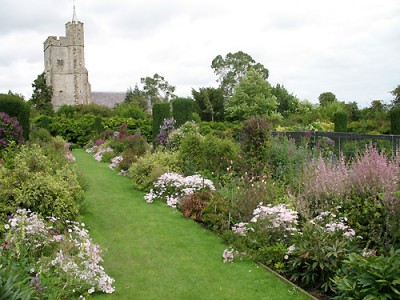
View of the church from the house garden (photo © Lynn Sherick)
Holy Cross Church was attached to Goodnestone Park, the estate of the Bridges family. Jane Austen’s brother Edward married Elizabeth Bridges in the church in 1791. When Jane and Cassandra paid extended visits to Edward and Elizabeth at their first home, Rowling House, on the Goodnestone estate, they worshipped at the church.
The tower and the north chancel wall are all that remain of the original Norman structure. The interior was remodeled in 1839 and is a fine example of the nineteenth century Gothic Revival style. Holy Cross is now the village church and a favorite venue for choral performances. It also functions two days a week as the village post office.
Past JASNA Grants and Their Uses
- 1998: Repairs
-
2006: Interior restoration
- 2007: Interior restoration
- 2009: Interior repair
- 2013: Organ restoration
St. Swithin's Church, Walcot, Bath | Show Details ↓
Location Map
Church Website
Contact: tim@stswithinswalcot.org.uk
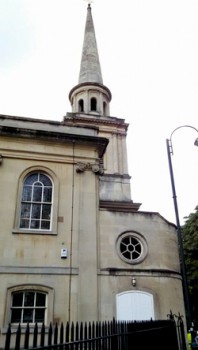
Photo © Amanda Jacobs
Jane Austen's parents, George and Cassandra Austen, were married in St. Swithin's Church, Walcot parish, in 1764. In 1805, while the family was living in Bath, George Austen died and was buried in the church crypt. His gravestone was later moved to the churchyard.
There has been a church on this site since 971; the foundations of the Saxon church are beneath the crypt. The original church was torn down, and the existing one completed in 1777, thirteen years before Jane Austen moved to Bath with her parents and sister. Designed by John Palmer, who also designed the Lansdown Crescent, the church is in the classic Georgian style.
Past JASNA Grants and Their Uses
- 2000: Repair of Rev. George Austen’s gravestone
- 2015: Printing leaflets on Austen ties to the church

Rev. George Austen's gravestone and plaque
(photo © Amanda Jacobs)
St. Nicolas Church, Great Bookham, Surrey | Show Details ↓
Location Map
Church Website
Contact: office@stnicolasbookham.org.uk

Photo © Lynn Sherick
Jane Austen's godfather, the Rev. Samuel Cooke, was vicar of St. Nicolas Church in Great Bookham. His wife, Cassandra Leigh, was a cousin of Jane Austen’s mother (also named Cassandra Leigh). Austen visited the Cooke family in Great Bookham in 1799 and again in June 1814, when she was writing Emma. Great Bookham is several miles from Box Hill and not far from Leatherhead, which is thought by some to be the model for Highbury.
St. Nicolas is over 1,000 years old.
Past JASNA Grants and Their Uses
- 2006: Preparation of booklet, 1800: Great Bookham in the Time of Jane Austen, Fanny Burney and R.B. Sheridan
- 2012: Restoration of the church tower
St. Margaret’s Church, Horsmonden, Kent | Show Details ↓
Location Map
Church Website (History tab has information on ties to Jane Austen.)
Horsmonden Village Website

Photo © Lynn Sherick
St. Margaret's Church is the final resting place of many of Jane Austen's forebears, including her great grandfather John Austen (1560-1620). The church has an Austen window and various railed tombs with the Austen crest. George Austen grew up in nearby Tonbridge, and Jane Austen worshipped here when visiting her Kentish relations.
Past JASNA Grants and Their Uses
- 2015: Repair of Austen family window
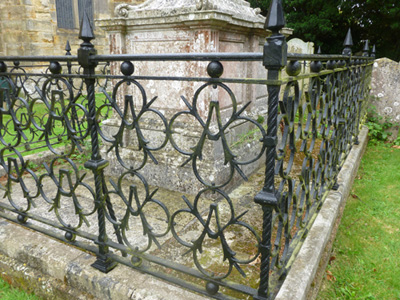
Railed Tomb with Austen Crest (photo © Lynn Sherick)
St. Peter and St. Paul Church, Tonbridge, Kent | Show Details ↓
Location Map (Click on the "Find Us" tab to display map.)
Church Website
Jane Austen's Connections to Tonbridge (Scroll down to find downloadable leaflet and audio recording.)
Contact: parishoffice@tonbridgeparishchurch.org.uk

Photo © Lynn Sherick
Jane Austen’s father, George, was born in Tonbridge, baptized in the parish church of St. Peter and St. Paul, and worshipped there as a youth while attending Tonbridge school and as an adult after returning from Oxford to be Usher of Tonbridge School. Members of the family of Jane Austen's remarkable great-grandmother Elizabeth Weller are commemorated in the church, and her son William, Jane Austen's grandfather, is buried there with her grandmother, Rebecca.
Past JASNA Grants and Their Uses
- 2006: Gift to Sevenoaks School, Tonbridge, for a plaque commemorating Elizabeth Weller, Jane Austen’s great-grandmother
- 2008: Development of exhibition for the Jane Austen & Tonbridge Circular Walk
- 2012: Restoration of a Richard Dodd painting of the church interior as George Austen would have seen it
- 2016: Cleaning of the Hooper and Weller family monuments in the church

Restored Dodd painting of church interior at time of George Austen (photo © Vivian Branson)
St. Paul’s Church, Covent Garden, London | Show Details ↓
Location Map
Church Website
Contact: info@actorschurch.org.uk

Photo © Amanda Jacobs
Jane and Cassandra Austen worshipped at this church when visiting their brother Henry in nearby Henrietta Street (1813-1814). It is known as "The Actors’ Church" because of its long association with the West End theatrical community.
Past JASNA Grants and Their Uses
- 2010-11: Restoration of pew in the Gallery

Restored pew in St. Paul's Church
(photo © Amanda Jacobs)
St. Peter's Church, Hurstbourne Tarrant, Hampshire | Show Details ↓
Location Map
Church Website
Contact via village website: http://www.hbt.org.uk/community/hurstbourne-tarrant-parish-7760/st-peters-church/
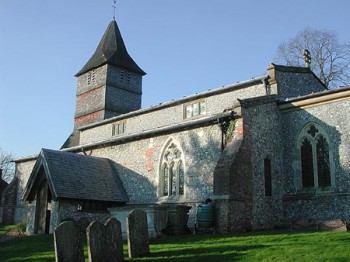
Photo © Allan Soedring
St. Peter's is near Ibthorpe House, where Jane Austen's friends Martha and Mary Lloyd lived with their widowed mother. Austen was a frequent visitor and would have worshipped at this church while staying with them. When Mary became the second wife of Austen's brother James in 1797, their marriage took place in St. Peter.
Past JASNA Grants and Their Uses
- 2006: Water line
- 2008: Altar cloth
Other Sites
Stoneleigh Abbey Chapel, Kenilworth, Warwickshire
Although Stoneleigh Abbey is not a church, we include it here as a fine example of an estate chapel. Jane Austen visited Stoneleigh Abbey in 1806 with her sister and mother. The chapel is considered by many to be the inspiration for the chapel at Sotherton Court in Mansfield Park.
St. Andrew’s, Colyton, Devon*
St. Mary Magdalene, Adlestrop, Gloucestershire*
Church of St. Michael and All Angels, Hamstall Ridware, Staffordshire*
*More information coming soon.
Photo, top: Interior of St. Nicholas, Steventon (© Allan Soedring)
